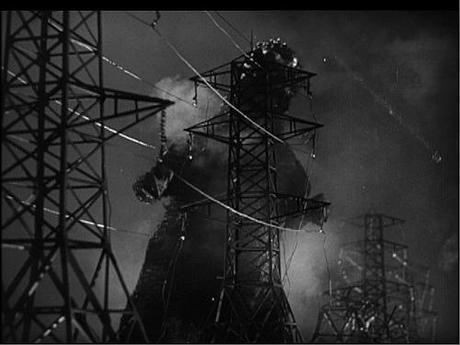
Abstract : Gojira (1954) is a Japanese film with two intertwined plots: 1) a monster plot about a prehistoric beast angered by atomic testing, and 2) a love plot structured around a conflict between traditional arranged marriage and modern marriage by couple’s choice. The film exhibits ring-composition (A B C D C’ D’ A’) as a device linking the two apparently independent plots together. Nationalist sentiment plays an important role in that linkage. the paper ends with a 6-page table detailing the actions in the film from beginning to end.
Introduction: Gojira, Analysis and Description
The Gojira/Godzilla franchise is the longest running franchise in movie history. It originates with the 1954 film, Gojira (the Japanese for Godzilla), about a large prehistoric beast that was disturbed by atomic testing and, in consequence, destroyed much of Tokyo before it was destroyed. The Japanese film was Americanized by eliminating some footage, adding new footage, and re-editing. This new film was released in America in 1956 under the title, Godzilla, King of the Monsters. The Japanese have so far made 27 more Godzilla films plus spin-off films about other monsters. The franchise also includes animated television programs, comics, and assorted merchandise.
This working paper is about that first Japanese film. It also has some remarks about the Americanized version. First comes a review essay of the Japanese film which makes the point that Gojira has two intertwined plots, the monster plot and a love plot. The love plot is about a conflict between two marriage customs, traditional marriage through parental arrangement, and a more modern marriage, in which the couple themselves make the choice. I suggest that the two plots are more than incidentally intertwined. Rather, Godzilla’s rage at Japan is also a proxy for old Japan’s rage over the waning of the old ways.
I then have some brief remarks about arranged marriage in Japan followed by a brief account of the Americanized version, which is changed from the Japanese version in two respects. The love plot is eliminated and an American reporter is added to frame the story. The audience sees the story through his reporting.
The fifth section demonstrates that Gojira exhibits ring-composition, in which the major sequences of the film are symmetrically arranged around one scene the serves as the structural center. Roughly the central third of the film consists of sequence begins and ends with meetings between a woman, Emiko Yamane, and her betrothed, Dr. Daisuke Serizawa, in an arranged marriage. The film’s structural center occurs between those two meetings and consists of a brief quarrel between Emiko’s father, Prof. Kyohei Yamane, and the suitor, Hideto Ogata, she wants to marry.
The paper’s next three sections examine other aspects of the film in more detail. Among other things they point out the role that nationalist sentiment plays in the plot and how that sentiment links the monster plot and the love plot.
The last section is a descriptive table detailing what happens in the film. It is through the examination of this table that I determined the film’s overall structure, which I’ve marked in the table.

